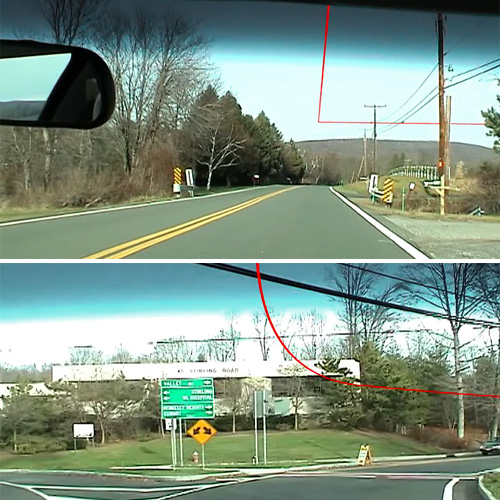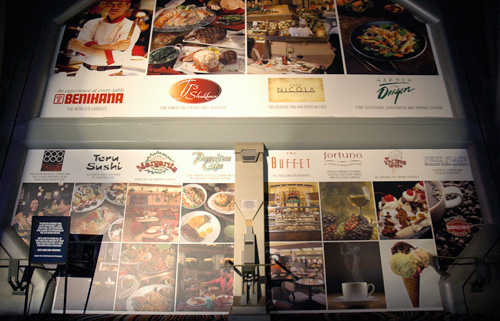
By Andrew Liszewski
So far I’ve been particularly unimpressed with any of the in-car GPS systems I’ve used. They’re definitely accurate when it comes to pinpointing your location, but when it comes to providing driving directions they’re not so hot. I think the biggest issue I have is trying to figure out what street they’re telling me to turn on, without glancing at the display and taking my eyes off the road.
But that’s exactly where this Virtual Cable navigation system shines. Instead of looking at a small 6 inch screen, or listening to less than exact turn by turn directions, it provides you with a red ribbon projected on your windshield showing the exact path you should be taking. The ribbon actually appears to exist in 3D space outside your car thanks to a patent pending volumetric display system using lasers and mirrors. The system makes it a lot easier to know exactly where an upcoming turn is, allowing you to slow down and get in the proper lane ahead of time.
Now while the technology seems to only exist in video demos at this time, the inventor Tom Zamojdo hopes to see it available one day for about $400 as a factory-installed option.
[ Virtual Cable ] VIA [ Ubergizmo ]





There is something like this in a game, Neocron. Instead of for cars it’s for people but I always thought the idea was a great one. I’m glad to see that maybe some day it’ll come out. I’d also like to see ‘linking’ between two cars so when you are following someone you don’t get lost when the prick cuts in front of you then stops at a green light for 5 min.
You’re kinda of screwed if you have a cat in your car no? 🙂
This would be great to use in the car – a much more natural GPS interface to follow. Hope Tom has thought of those who are color blind though who might end up following the overhead power lines instead..!
Now I just need one of these installed in my head so don’t get lost walking around too…
The virtual cable will really helps a lot of drivers when traveling. I could include this as best fuel saver product because you will easily find where your route is. Great job for this!
This is amazing. Does this technology really exist?
<a http://carheathrowlondon.ruqqa.com>car heathrow london info
This application is a clever twist on the classic “kick apps” like Zombies, Vampires, Food Fight
and mirror two follow other cars
Is this technology available yet? I think it has been released but not sure with what sets.
Is this technology available yet? I think it has been released but not sure with what sets.
I wonder if it wouldn't be more confusing than helpful. It could raise the accident rate.
The Global Positioning System (GPS) is a satellite-based navigation system made up of a network of 24 satellites placed into orbit by the U.S. Department of Defense. GPS was originally intended for military applications, but in the 1980s, the government made the system available for civilian use. GPS works in any weather conditions, anywhere in the world, 24 hours a day. There are no subscription fees or setup charges to use GPS.
Satellite navigation dates back a lot longer than many people realize. The principles behind SatNav were first tested back in 1967, but it took nearly 30 years before the NavStar GPS System first began operation as a military application in the mid 1990s. Civilian use of GPS navigation was made available soon after the military launch, but the initial costs of using the system were very high, and required ongoing subscriptions to be paid. The first people who took advantage of GPS were pilots, and surveyors, who needed to be able to measure distances with pinpoint accuracy. In the early days , an affordable GPS auto navigation system was out of reach for the average car owner.
Agree 100%
As we are running a removal business for some time now. I can assure with experience of constantly being on the road that this system will revolution the way we drive. GREAT article.lol
will the lasers affect my speed trap detector?
Yes, George. It should have all those features built-in.
It would truly be amazing.
Yes, great idea – but some things that are safe for the couch (like drinking and driving, putting your feet up on the dash, having people walk between you and the screen) are not so safe for real driving. I think that users of this system will find that its more than a car service they need at the mechanic's for this. I like the good old-fashioned method of looking up your route on a map beforehand and pulling over if you don’t know where you are! Your GPS can still help you with unsigned streets and distances between intersections, etc. Just don’t rely on it so much, and we won’t need dangerous things like this in the car.
car service
Yes, great idea – but some things that are safe for the couch (like drinking and driving, putting your feet up on the dash, having people walk between you and the screen) are not so safe for real driving. I think that users of this system will find that its more than a car service they need at the mechanic's for this. I like the good old-fashioned method of looking up your route on a map beforehand and pulling over if you don’t know where you are! Your GPS can still help you with unsigned streets and distances between intersections, etc. Just don’t rely on it so much, and we won’t need dangerous things like this in the car.
car service
Wow that would be awesome. I hate driving because I get lost so frequently. That also would be great for professions like Truck driving because they have to manuever huge vehicle's like Boom Trucks around tiny streets once off the highway.
i hope in the future we have that technology man and van